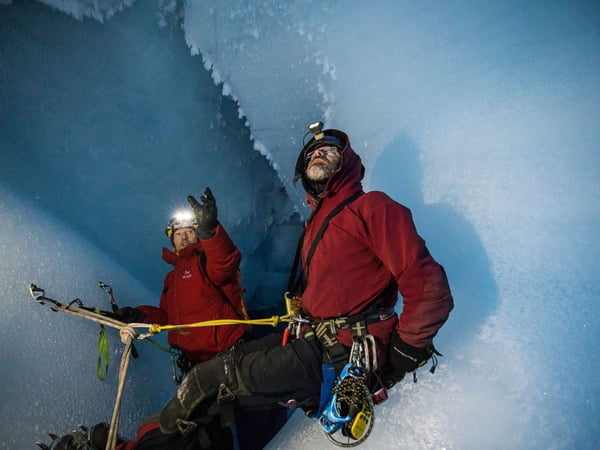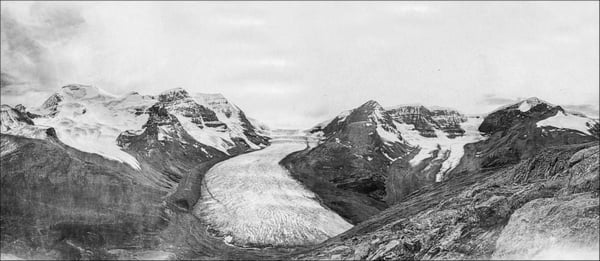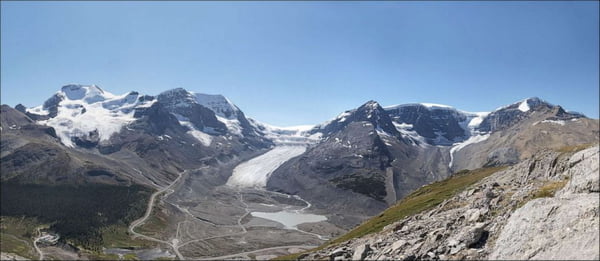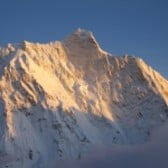
Daily Mountain
48 years, Australia
Legendary ice climber Will Gadd helps climate scientists navigate melting glaciers
For Will Gadd, “fear and danger are constant – they remind me to pay attention.”
The places Gadd works in “are really hazardous,” he said. “If you are not afraid of that environment, something is wrong with you.”
Where most see a remote and unforgiving landscape, Gadd sees a playground. There’s no mountain high enough, no waterfall dangerous enough for this extreme ice climber.
 Jason Gully, a glaciologist at the University of South Florida, recently enlisted Gadd’s help on an expedition to the Greenland ice sheet. Courtesy of Red Bull/ Christian Pondella
Jason Gully, a glaciologist at the University of South Florida, recently enlisted Gadd’s help on an expedition to the Greenland ice sheet. Courtesy of Red Bull/ Christian Pondella
Even the mighty Niagara Falls proved no match for Gadd –- he climbed to the top of the frozen cascades in 2015, the first person to make the climb.
Gadd is a living legend in the climbing world. Now he’s using his prowess to sound the alarm about climate change.
That mission has taken him from the last remaining ice on Africa’s highest peak -– Kilimanjaro, to the depths of the melting Arctic.
It’s been a remarkable journey that all began in the far freezing reaches of the Canadian Rockies.
“I've been coming here for 45 years,” Gadd told “Nightline." “I remember being a kid in elementary school and driving out here in the family vehicle and the glacier being like right there, and now it's way back there.”
Today, each return visit is a warning sign of the effects of climate change.
 The Athabasca Glacier in Alberta, Canada is seen here in 1917. Courtesy of the Mountain Legacy Project
The Athabasca Glacier in Alberta, Canada is seen here in 1917. Courtesy of the Mountain Legacy Project
“When I see this landscape, something's wrong. There should be a glacier here,” Gadd said. “Glaciers are the symptom -- when glaciers are retreating this quickly, something is changing very, very quickly in our world.”
Gadd’s backyard ice, the Athabasca Glacier, has lost more than half its volume and receded nearly a mile in the past 125 years.
Today, each return visit is a warning sign of the effects of climate change.
“When I see this landscape, something's wrong. There should be a glacier here,” Gadd said. “Glaciers are the symptom -- when glaciers are retreating this quickly, something is changing very, very quickly in our world.”
Gadd’s backyard ice, the Athabasca Glacier, has lost more than half its volume and receded nearly a mile in the past 125 years.
 The Athabasca Glacier in Alberta, Canada is seen here in 2011. Courtesy of the Mountain Legacy Project
The Athabasca Glacier in Alberta, Canada is seen here in 2011. Courtesy of the Mountain Legacy Project
He said he and the scientists found new lifeforms down there that are not well studied.
“That's launched another center of research and that's also exciting…. To be able to help collective knowledge move forward, that is really satisfying to me.”
The United Nations recognized Gadd’s impact in 2018, naming him a “Mountain Hero” for his work in raising awareness on disappearing glaciers.
Jason Gully, a glaciologist at the University of South Florida, recently enlisted Gadd’s help on an expedition to the Greenland ice sheet.
“The Greenland ice sheet in October is a freezing cold place to work," Gully said. "We’ve got winds running around 50 miles per hour, we’ve got temperatures that are dropping around zero. We’d drop into what turned out to be one of the coolest caves I’ve ever entered.”
Gadd took scientists down a plunging glacial cave called a “moulin,” giving them unprecedented access.
“There’s a tremendous amount of research going on in Greenland right now trying to understand how the Greenland ice sheet’s gonna affect sea level rise, because it’s the second largest ice sheet on the planet,” Gully explained. “If the Greenland ice sheet were to melt, it would raise sea level about 5 to 7 meters.”
The team had hoped to dive into the frigid waters, but science, deep inside the ice sheet, comes with risks.
Gully said they weren’t prepared for “how unstable the cave was.”
“I was afraid there was so much debris and so much power in there that it was not a safe place to be,” Gadd said. “This research is important, but it's not worth dying for right there.”
Gully said there were “big chunks of ice” that had fallen from the ceiling to the floor.
“We understand more about how the Greenland ice cap works now as a result of the work that Jason and I did together,” Gadd said. “I love that, I’m an athlete not known for being super smart, but I'm helping some super smart people get in there.”
Ice climbing is complex and dangerous. Gadd teaches the basics to climate scientists so they can learn more about the future of the planet than anyone thought possible.
As he sees it, there’s no time to waste getting up to speed.
“I am optimistic that we can stem the tide in some way, but I think we're going to have a lot of pretty wild change on our planet in a relatively short order,” Gadd said. “I want to teach my kids to expect radical change and to embrace it and move forward quickly. So short term we're in it, it's going to be difficult, long term I think when people pull together they can do anything.”
Images provided courtesy of the Mountain Legacy Project and Library and Archives Canada / Bibliothèque et Archives Canada. More images from this location at explore.mountainlegacy.ca
This article first appeared on http://abcnews.go.com. The original can be read here.





